Constantine and Christianity
A remarkable turn of events in 313 AD
The Edict of Milan was one of the first documents in the history of the world to promote freedom of religion. It was a boon for Christians who up until that point had been severely persecuted during a ten year policy of intolerance initiated by the emperor Diocletian. The document was beneficial for all parties. It gave those who served pagan gods freedom to worship as they wished, but it was even more advantageous for Christians, whose faith had previously been outlawed. The Roman policy of intolerance was over.
Both Constantine and Licinius, another co‑emperor of Rome (ruling Thrace, Pannoinia, and Illyricum), marked their victory as new emperors over the Roman Empire by agreeing to an Edict in the city of Milan during the month of February 313 AD. In June of that year Licinius published and spread the law to the people of the empire. It was a momentous document which would be remembered until the end of the empire.
THE TEN YEARS OF REVELATION 2:10
The ten year period of intolerance was one of the most severe persecutions of Christians in the Roman Empire.
EXCERPT FROM THE EDICT MILAN
“When you see that this has been granted to [Christians] by us, your Worship will know that we have also conceded to other religions the right of open and free observance of their worship for the sake of the peace of our times, that each one may have the free opportunity to worship as he pleases; this regulation is made that we may not seem to detract from any dignity of any religion.” 1
This tribulation upon the Lord’s people was foretold in Revelation 2:10, which refers to a ten year period from 303 to 313 AD that began during the reign of Diocletian, ending with the Edict of Milan. This relieved the Church of a period of savage persecution. However, in the aftermath, rulers of the empire would intrude further upon the Church. Eventually true Christians were again persecuted, under policies that originated from the church state system that would follow later.
CONSTANTINE’S CONVERSION?
After his huge victory at the Milvian Bridge against Maxentius in October 312, Constantine claimed conversion to Christianity. Three years later, in 315, he had this event marked with the construction of an arch in Rome to commemorate the battle. Upon his rise to power he attempted to unite different portions of the empire and started a campaign against those who disputed his power.
The story that Constantine told his personal historian, Eusebius, about his conversion, was first recorded about seven years later. He stated that he saw a cross in the sky in the noonday sun and that the Lord Jesus appeared to him later that night during a dream to explain the vision to him. Constantine said that after hearing the words “by this sign conquer,” he had the sign of the cross painted on the shields of each of his soldiers. He further alleged that it was both the vision and the dream that helped inspire the battle victory. However, on the arch Constantine built to record the triumph, no such vision appears.
A close inspection of Constantine’s arch shows that there are no Christian symbols on it at all. It does not show a cross in the sky, no banner lifted high with the cross, nor any crosses painted on the shields of his warriors. If this is really what happened, we should expect to see it detailed for us on the arch itself, since it was created was to memorialize the momentous battle at the Milvian bridge that caused his conversion.
The arch was built shortly after Constantine’s victory, and before the version that Eusebius recorded. Near the top of the arch is a frieze that contains the original story Constantine told, depicting his victory. The story on this frieze illustrates the generals and pagan gods Constantine attributed to helping him win. Pagan gods from the Roman pantheon are depicted all over the arch, but none as prominently as Sol Invictus, the sun god of the Roman Empire. Instead of Jesus Christ, the arch depicts the god of the river Tiber, a winged goddess of victory, and Roma, the goddess of Rome.
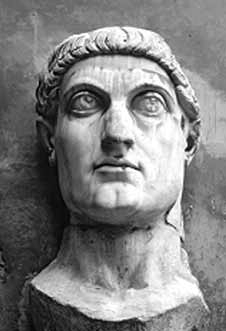
Constantine
Three former pagan Emperors are also shown on the arch with reliefs taken from other arches, including the Philosopher Marcus Aurelius, the Conqueror Trajan, and the Statesman Hadrian. Above the pagan sun god, Sol Invictus, is an inscription commissioned by Constantine which reads: “To the emperor Caesar Flavius Constantine Maximus, Pius Felix Augustus, since through divine inspiration and great wisdom he has delivered the state from the tyrant and all his factions, by his army and noble arms, the Senate and the Roman People, dedicate this arch decorated with triumphal insignia.”
A CHANGING AND EVOLVING STORY
This story evolved over time. Rather than the story about the cross in the sky that Eusebius recorded years later, the Arch shows that Constantine saw himself as divinely inspired by Sol Invictus. Later, in Eusebius’ first account, no mention is made of Constantine’s vision or dream. This version of the story appeared in versions of the story years later.
The arch is the earliest record of this battle, but there is another record. The emperor also minted a coin depicting himself with (and as) Sol Invictus. The imperial tradition was that the emperors were under the teaching of the god Apollo, and that they were associated with Sol Invictus, the Unconquered Sun. Several contemporary portraits, coins, and sculptures commissioned by Constantine depict him with the rayed crown of Sol Invictus. Years after his conversion to Christianity, Constantine continued to mint coins with himself as this pagan Sun God. This symbol appears on most of his coins between 313 and 317.
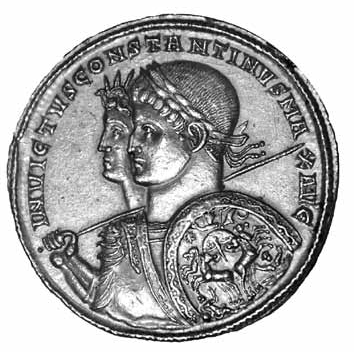
Coin depicting Sol Invictus and Constantine
When Constantine had the arch built, he also topped it off with a frieze and a statue of himself in a four horse chariot just like the Sun God Apollo. This statue has not survived as it was destroyed centuries ago, but the frieze remains. This image was also used by Constantine’s sons after the death of their father when they minted a coin suggesting the deceased emperor’s ascent to heaven in a four horse chariot, with the hand of the Sun God in the heavens reaching towards the late emperor to accept him into the pantheon.
This well illustrates the beginning of the period of time prophesied about in Revelation 6:1‑8, which also portrayed four horses — four horses which symbolized the degradation of the papal doctrine and its alliance with the state.
When Constantine founded a new city in the East, he did not name it after Jesus or the Apostles, but after himself. In his great city of Constantinople he also built a giant stature of Apollo the Sun God, but replaced the face of Apollo with his own. Constantine chose not to be baptized until he was near death. Before he died he arranged to have himself buried with twelve coffins that he called the Twelve Apostles, with himself as the thirteenth.
THE RISE OF THE 1260 DAYS
The rise of the church‑state alliance proceeded through many stages — from the Edict of Milan in 313, the Edict of Theodosius in 381, the Code of Justinian, conquering the last of the Arian tribes at Ravenna in 539, to the crowning of Charlemagne as emperor in 800. This period was not only illustrated on the coin of Constantine’s ascent to the throne of God with four horses, but was also predicted in the vision of the woman and the man‑child in Revelation 12. In this vision the man‑child ascended to the throne of God before the beginning of the 1260 year period.
The text says that the woman “gave birth to a son, a male child, who is to rule all the nations with a rod of iron; and her child was caught up to God and to His throne” (Revelation 12:5‑6 NAS).
Just as the woman called Zion travailed and brought forth a man‑child in the prophecy of Isaiah (Isaiah 66:7,8), the woman in this text is the early Jewish Christian Church (1 Corinthians 12:12) which found itself at a new beginning after the death and resurrection of Christ in the spring of 33 AD. In this prophetic vision the woman gave birth to a child whose life was imperiled by a great red dragon (Pagan Rome), but delivered from this threat by being caught up to safety.
All seemed well. But thereafter the woman required to flee into the wilderness, where she would be nourished and cared for by God for 1260 years (from 539 to 1799).
In Revelation 12:10, after a war in heaven in which the Dragon lost its control of the ecclesiastical heavens, there is a loud declaration that “Now is come salvation, and strength, and the kingdom of our God … for the accuser of our brethren is cast down.”
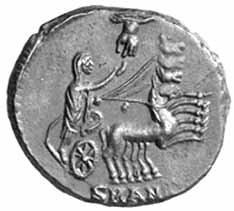
Coin minted showing Constantine ascending in a four horse chariot.
However, this victory of Christianity over paganism corrupted. The Christian victory was exercised through the nominal Church that gained influence with political rulers such as Justinian, and the woman (the true Church) found herself in continued persecution for 1260 years.
If the woman is the true Church, as an institution, then her various children would be its members, subject to continuing persecution. “The dragon was wroth with the woman, and went to make war with the remnant of her seed, which keep the commandments of God, and have the testimony of Jesus Christ” (Revelation 12:17). Ultimately the saints obtain dominion at the end of the age (Revelation 2:27, 19:15). But Christian rulership during the Gospel Age was exercised by the nominal Church, rather than the true Church.
The dragon in this vision has seven heads, ten horns, and seven diadems (Revelation 12:3). Comparing these symbols with those of the beasts in Daniel 7 (who have a total of seven heads and 10 horns), we see that the dragon of Revelation pictures pagan Rome, which succeeded the other empires and aggregated their substance into itself. This dragon is described as a serpent, a deceiver, because the trouble from the dragon originated with Satan.
Constantine connected his victory to the intervention of God, thus indicating that he had his authority by divine right. However, his mixing of state influence with the Church would lead by steps to the persecution of the Church during 1260 years of Papal supremacy.2 Then would come a dreadful persecution of the saints by the nominal church supported by governmental power, represented by the rule of Jezebel and Ahab (compare Revelation 2:20).
After Jesus was raised, frustrating Satan’s efforts to destroy Christ, Satan then attempted to kill the body of Christ from the time of the apostles, to Diocletian’s edict of intolerance, to Milan’s edict of tolerance, to the time of Justinian, through the middle ages, the Crusades, and the Reformation. The dragon, pagan Rome, lost its power to persecute the Church in 313 because of the Edict of Milan. This year may also was a culmination of a period of gestation indicated in Revelation 12:4, “The dragon stood before the woman who was about to give birth, so that when she gave birth he might devour her child.”
REVELATION SYMBOLS IN ARCHEOLOGY AND HISTORY
Many of the symbols of Revelation are also found in the history of Rome. Constantine’s coins, mentioned earlier, show how the emperor viewed himself as ascending to the heavens and divinely inspired. In Revelation 1:16 Jesus is depicted as having seven stars in his right hand, representing seven messengers to whom the message of the seven church are directed (Revelation 2, 3).
It is fascinating to note that at the time John was writing Revelation, the emperor Domitian (81‑96 AD) minted a coin which depicted his son standing on the earth ascending to heaven with seven stars around him. In Revelation 17:1‑4, the harlot woman of the false church is described as having a golden cup in her hand and sitting on the waters. Incredibly, this scene is illustrated on a Papal coin showing how Papacy viewed itself.
To determine the meaning of the prophecy of the pregnancy in Revelation twelve, we need to determine its length. Human pregnancies are 40 weeks in length, which would be 280 days. Starting with the beginning of the Church after the death of Christ in the spring of 33 AD, and adding 280 years, takes us to the spring of 313 and the Edict of Milan — the year ending the 10 years of Revelation 2:10. This is the time the child was “born” and “caught up” for protection from the threat of the dragon.
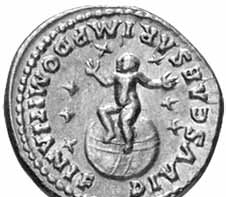
Domitian’s son with 7 stars
SYMBOLIC NUMBERS
The numbers used to compute this period of time can add to our understanding of this prophecy. Seven in Scripture denotes something complete or perfect, sometimes applied to Jesus, or his Church, which is developed in seven stages during the Gospel Age. The number forty signifies a period of trial.
These two numbers together indicate a trial upon the Church, passing through many experiences for the incipient Christian community that threatened its very life. This period of time, culminating in ten years of special distress for the Church, was foretold three centuries before, right to the very year.
A CHRONOLOGICAL POSSIBILITY FOR THE 1600 FURLONGS
The harvest chapter of Revelation 14 also references the date 313. “And the winepress was trodden without the city, and there came out blood from the winepress, even unto the bridles of the horses, as far as a thousand and six hundred furlongs” (Revelation 14:20 ASV).
In Scripture, horses sometimes represent doctrines. In retribution against Christianity, those in charge of doctrine will be replace. Zechariah 14:20 says, “in that day there will be inscribed on the bells of the horses, ‘HOLY TO THE LORD.’ ” The doctrines will be vibrant, holy, and refreshing. The old dogmas of Christendom will be removed and refreshed with Holiness.
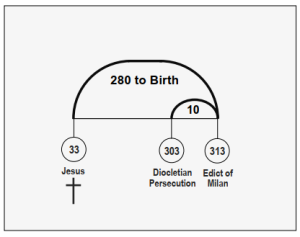 This number 1600 is forty squared (40 x 40). The square of a number emphasizes and intensifies the underlying symbol, in this case 40, trial, testing, or judgment. Perhaps here the 1600 furlongs indicates a period of 1600 years when judgment would fall on the systems of Christendom in World War I.
This number 1600 is forty squared (40 x 40). The square of a number emphasizes and intensifies the underlying symbol, in this case 40, trial, testing, or judgment. Perhaps here the 1600 furlongs indicates a period of 1600 years when judgment would fall on the systems of Christendom in World War I.
In 314 Constantine defeated Licinius, and though the latter continued for some years, this was a step in the consolidation of power under Constantine. Thereafter, 1600 years bring us to 1914, when the image of Daniel 2 was smitten on its feet, and the toes of iron (political) and clay (Papal) began to be removed in the summer winds of the harvest (Daniel 2:35). (See an additional suggestion in the article following, on “The Council of Arles.”)
SUMMARY
The Edict of Milan in 313 AD closed out the 10 year “great persecution” initiated by Diocletian, that ranged from 303 to 313. With the close of this period the “man child” escaped the threatened destruction from the dragon of Revelation 12:4, as the organized persecution of the incipient Christian community was stopped. Thus the man‑child was “born” 40 weeks of years, 280 years in all, after the fledgling Church began in the year 33 AD. From Constantine’s victory over his rival Licinius the next year, 1600 years take us to 1914 when the 10 toes, the remnants of Roman domination, were brought into judgment.
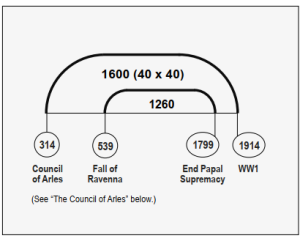
Thus in the Edict of Milan and its aftermath we have three independent methods which touch upon times of prophetic fulfillment. Seeing prophecy fulfilled in the historical record should increase our faith that what God has promised has come true, and will continue to come true.3
— Br. Jeff Mezera
(1) “Edict of Milan,” Lactantius, On the Deaths of the Persecutors (De Mortibus Persecutorum), chapter 48, opera, ed. O. F. Fritzsche, II, page 288 sq. (Bibl Patr. Ecc. Lat. XI).
(2) Editor’s note: This period of 1260 years, from 539 to 1799, began during the time of Emperor Justinian, who reigned from 1 August 527 to 14 November 565.
(3) Editor’s note: A related article on this subject, by Br. Tom Gilbert, is “Development of the ‘Trinity Doctrine,’ ” Beauties of the Truth (November 2010).
